Meet the adorable delphinium in the garden
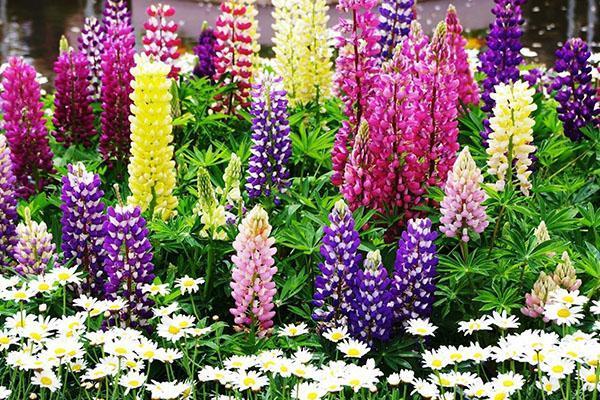 To create an original composition of bright flowers at their summer cottage, many summer residents grow perennial delphinium. It amazes with its colors and grandeur. If you look at it from the side, it seems that giant candles with colored lights appeared in the garden. Despite this, the plant is not difficult to grow at home. The main thing is to adhere to the basic principles of planting a flower. What is the king of the country flower bed - delphinium? Are there any peculiarities of its cultivation? The answers to these questions will help you fall in love with the unique creation of nature.
To create an original composition of bright flowers at their summer cottage, many summer residents grow perennial delphinium. It amazes with its colors and grandeur. If you look at it from the side, it seems that giant candles with colored lights appeared in the garden. Despite this, the plant is not difficult to grow at home. The main thing is to adhere to the basic principles of planting a flower. What is the king of the country flower bed - delphinium? Are there any peculiarities of its cultivation? The answers to these questions will help you fall in love with the unique creation of nature.
Name history and main characteristics
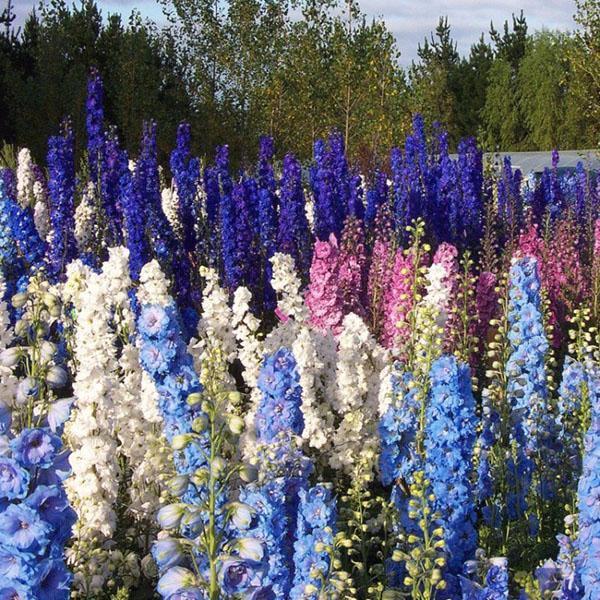 Almost all names and titles have their own mysterious history. Delphinium is no exception. One of them sounds like this.
Almost all names and titles have their own mysterious history. Delphinium is no exception. One of them sounds like this.
Many centuries ago, when the mythical gods of Greece controlled every human act, a talented sculptor lived on earth. His girlfriend tragically died. To find solace, he made a statue of her from stone, and then revived it. Such an act did not like the evil gods, and they turned the romantic into a dolphin. The girl cried bitterly on the seashore, hoping to see her lover. After a long time, a dolphin sailed to her and laid a pretty blue flower on her lap. It was named delphinium as a reminder of true love.
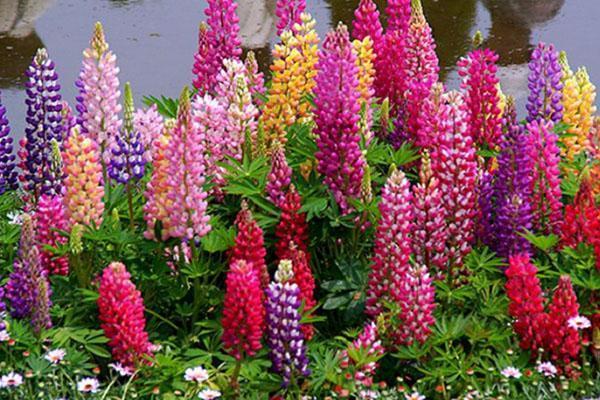 There is an opinion that the flower got its name due to the fact that, when unopened, it resembled a dolphin. It is often known as larkspur or spur. A related variant of the plant (annual, perennial) was combined into a group, the name of which is sokirki. Some gardeners believe that the flower is named after the Greek city of Delphi, where it grows in great numbers. Whichever story turns out to be true, it does not detract from the magnificence of the garden beauty.
There is an opinion that the flower got its name due to the fact that, when unopened, it resembled a dolphin. It is often known as larkspur or spur. A related variant of the plant (annual, perennial) was combined into a group, the name of which is sokirki. Some gardeners believe that the flower is named after the Greek city of Delphi, where it grows in great numbers. Whichever story turns out to be true, it does not detract from the magnificence of the garden beauty.
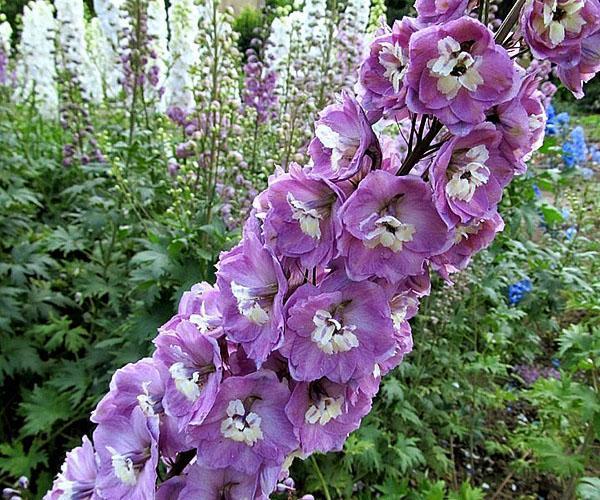 Today, approximately 450 species of the stately flower are known. The habitat extends from China to the tropics of the African continent. Unique photos of the delphinium help to see the flower in all its pristine beauty.
Today, approximately 450 species of the stately flower are known. The habitat extends from China to the tropics of the African continent. Unique photos of the delphinium help to see the flower in all its pristine beauty.
The plant belongs to the Buttercup family. The bud has a fairly large size. Sometimes it can reach 2 meters. The inflorescences are located along the shoot and resemble a standing candle. There are the following shades:
- sky blue;
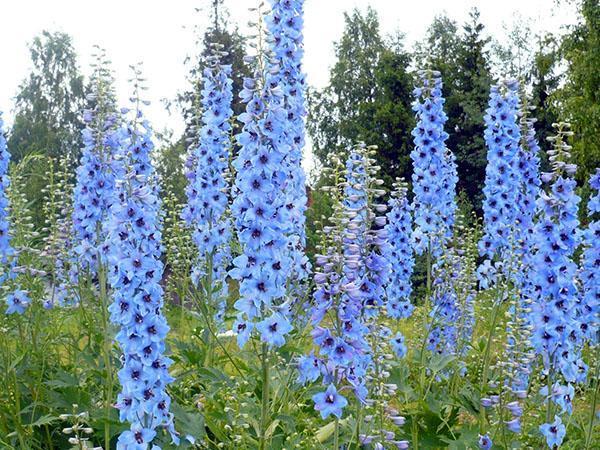
- blue;
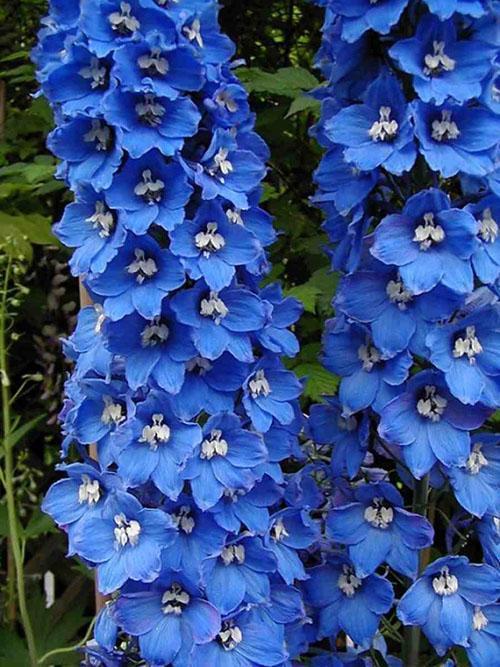
- lilac;
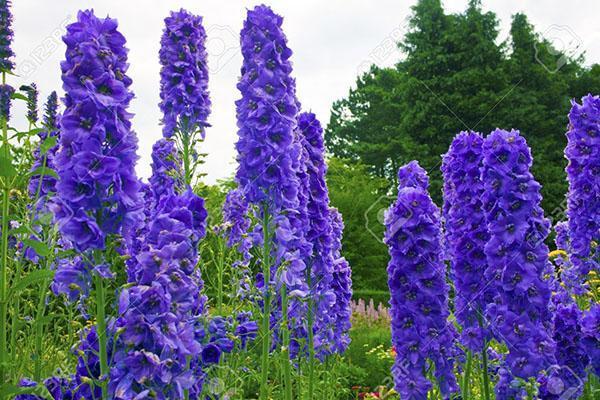
- snow-white;
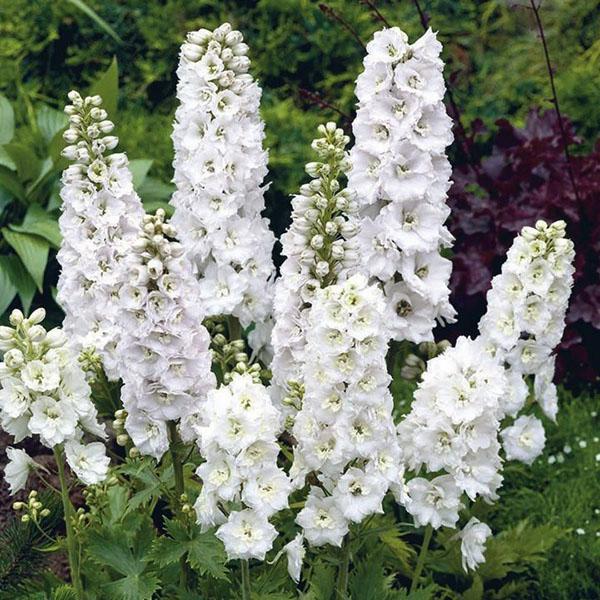
- purple;
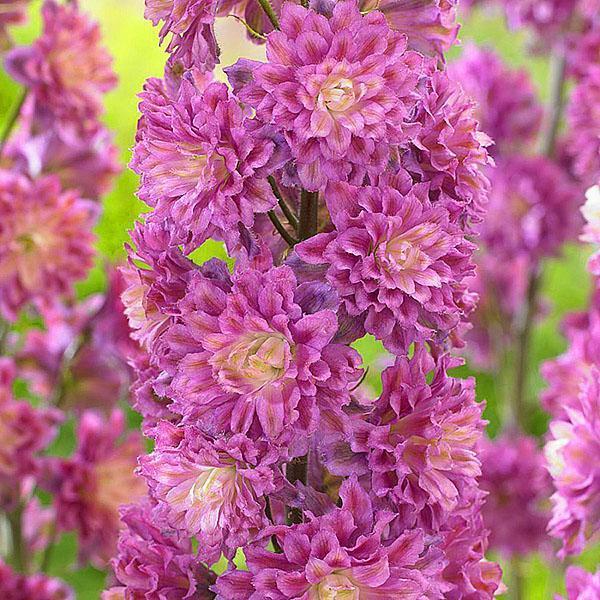
- red;
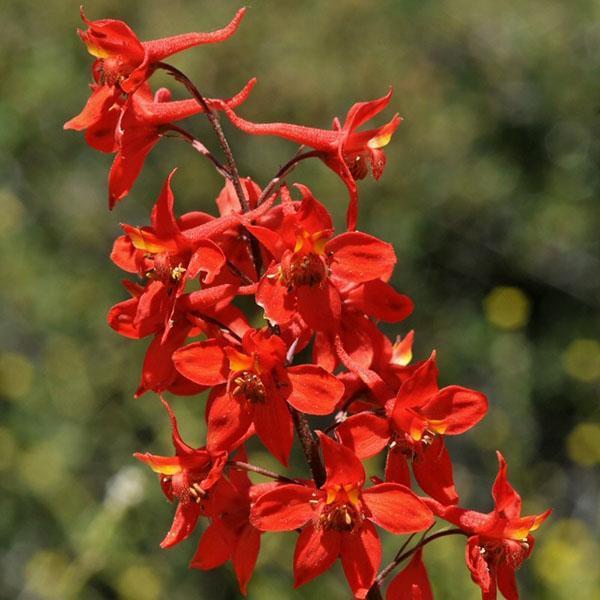
- pink.
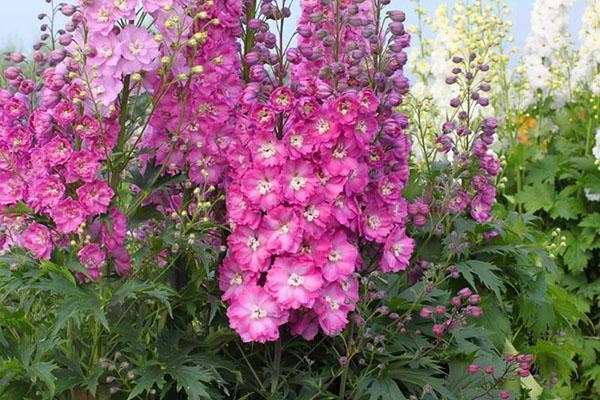
Perennial and annual variants are grown, mainly from seeds. The most popular annual varieties have long been loved by connoisseurs of flora.
Ajax
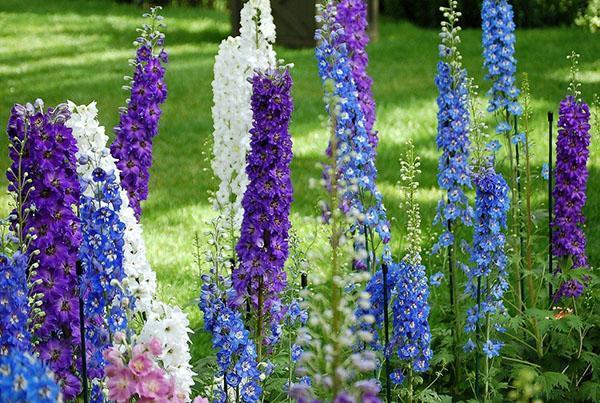 The plant was bred by combining two varieties of delphinium. The result is an original flower up to 100 cm high. Sitting leaf plates have a thick section. Inflorescences in the form of a huge spike grow approximately 30 cm and are found in a variety of shades.
The plant was bred by combining two varieties of delphinium. The result is an original flower up to 100 cm high. Sitting leaf plates have a thick section. Inflorescences in the form of a huge spike grow approximately 30 cm and are found in a variety of shades.
Lovers of miniature plantings grow dwarf varieties that grow only 35 cm from the ground. Delicate double buds are painted in bright colors and bloom until the first frost.
Field
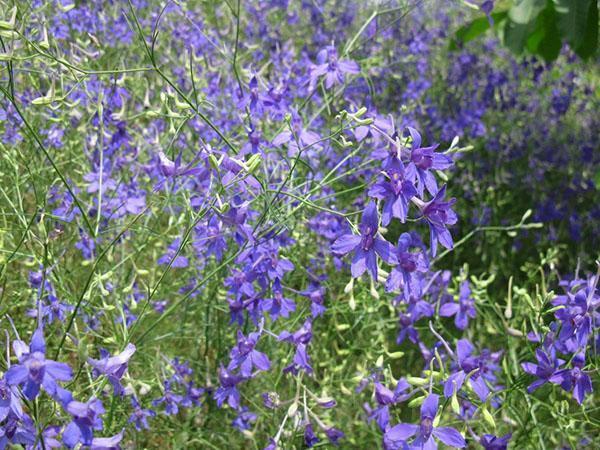 The annual delphinium flower has been cultivated since 1572. It grows up to a height of 2 meters. The buds are simple and luxuriantly double. A shade of traditional character. Blooms in June. The last "lights" at the beginning of autumn.
The annual delphinium flower has been cultivated since 1572. It grows up to a height of 2 meters. The buds are simple and luxuriantly double. A shade of traditional character. Blooms in June. The last "lights" at the beginning of autumn.
Delphinium perennial
Scientists began to develop perennial varieties in the 19th century. As a result, a number of original species appeared:
- Barlow;
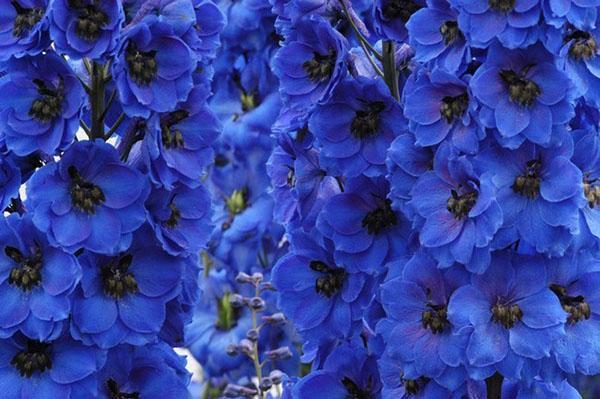
- "Belladonna";
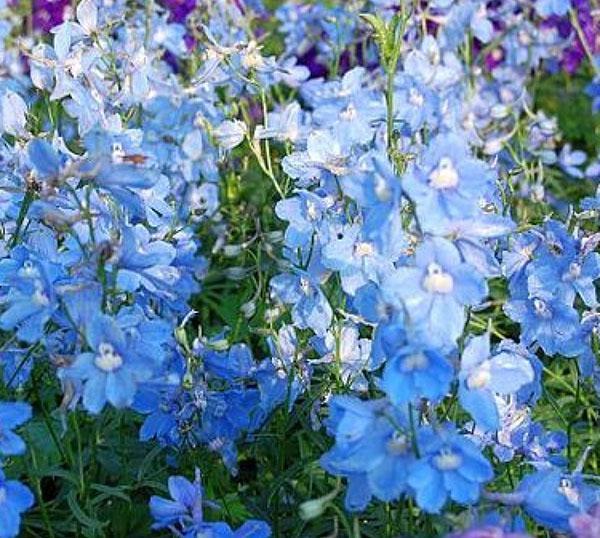
Today, gardeners grow various types of perennial delphinium. The main feature is the unique shades of the buds. There are about 800 variations of them. Inflorescences are of a simple character, double and semi-double. The diameter of the flowers is from 2 to 9 cm.
To create backyard beds, breeders offer flowers of different heights - undersized options, giants and medium-sized plants.
Depending on the area of origin, the flowers of the perennial hybrid delphinium were divided into three main groups: Marfinsky, New Zealand and Scottish. Each of them has its own characteristics.
Marfinsky group of delphiniums
For example, the plants of the Marfin group are resistant to low temperatures. They are distinguished by their unique decorative effect. Large semi-double inflorescences are decorated with contrasting spots that resemble the human eye. These include the following varieties:
- the original "Pink Sunset";
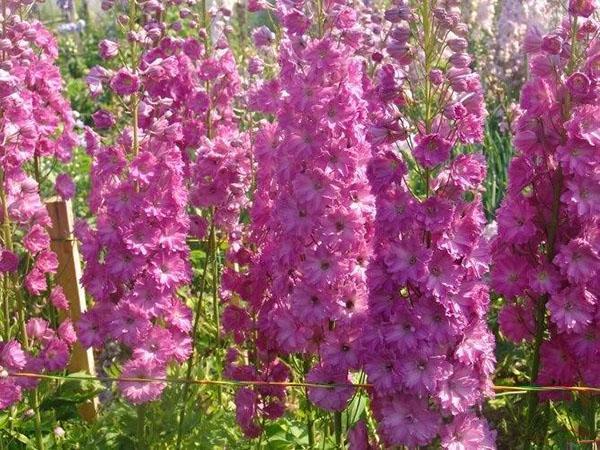
- gentle and mysterious "Morpheus" and incomparable "Blue lace";
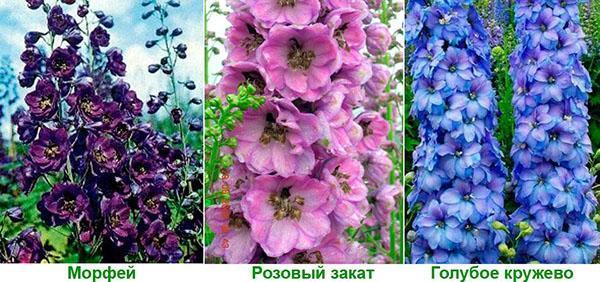
- refreshing "Snow Lace".
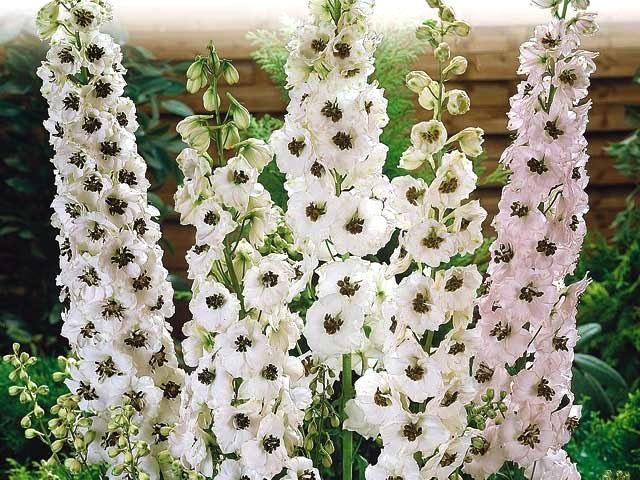
It is almost impossible to grow flowers of the Marfin group from seeds. The main reason is that they do not preserve the varietal characteristics of the plant.
New Zealand delphinium group
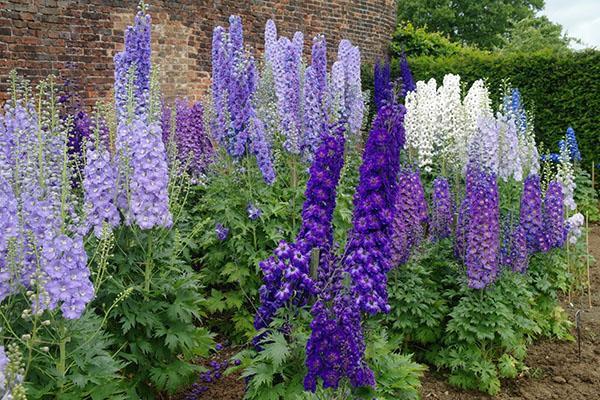 Delphiniums, which belong to the New Zealand group, can grow up to two meters in height. They differ in double and semi-double buds. Some species have corrugated petals. The flowers are resistant to disease, are not afraid of the cold, perfectly preserved in cut. The most common species are valued all over the world:
Delphiniums, which belong to the New Zealand group, can grow up to two meters in height. They differ in double and semi-double buds. Some species have corrugated petals. The flowers are resistant to disease, are not afraid of the cold, perfectly preserved in cut. The most common species are valued all over the world:
- "Sweethearts";
- Pagan Purples;
- Sunny Skies;
- "Blue Lace";
- Green Twist.
Their stately beauty never goes out of style. This is the beauty of flowering plants.
Scottish Delphinium Group
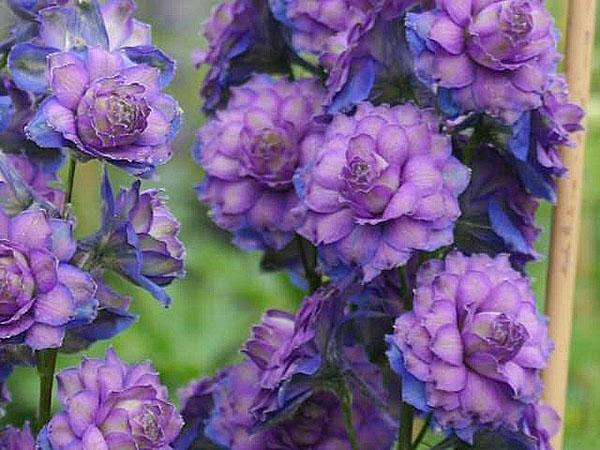 Scottish delphiniums attract with their original super double buds of various shades, which sometimes have about 60 petals. If the plant grows up to one and a half meters, then the inflorescence is 80 cm in total length. Perennial is unpretentious to weather conditions.
Scottish delphiniums attract with their original super double buds of various shades, which sometimes have about 60 petals. If the plant grows up to one and a half meters, then the inflorescence is 80 cm in total length. Perennial is unpretentious to weather conditions.
If you practice growing from seeds, the delphinium retains varietal parameters. The following popular types are known today:
- "Sweet Sensation";
- "Blueberry Pie";
- "Deepest Pink";
- Morning Sunrise.
Truly beautiful masterpieces of creation. But are there any secrets of growing a delphinium from seeds at home? Let's try to figure it out.
The main principles of growing a flower
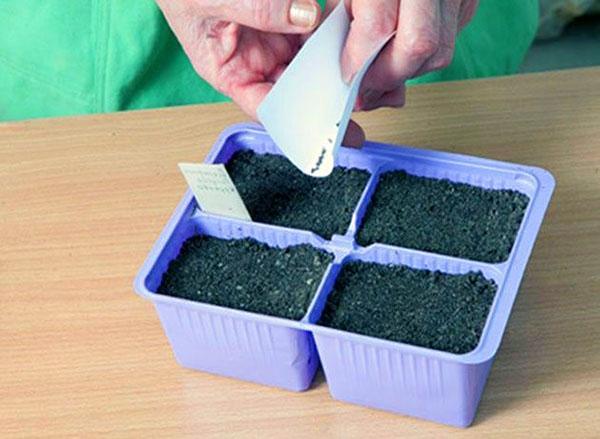 The first step is to prepare a suitable soil for planting the plant. It is best to mix the same amount of garden soil, peat and humus. Add sifted sand (half of 1 part), perlite (0.5 cups per 5 liters of soil) and hold the mixture over the steam of a water bath for 60 minutes. During this time, the seeds of various weeds and fungal spores will be destroyed.
The first step is to prepare a suitable soil for planting the plant. It is best to mix the same amount of garden soil, peat and humus. Add sifted sand (half of 1 part), perlite (0.5 cups per 5 liters of soil) and hold the mixture over the steam of a water bath for 60 minutes. During this time, the seeds of various weeds and fungal spores will be destroyed. 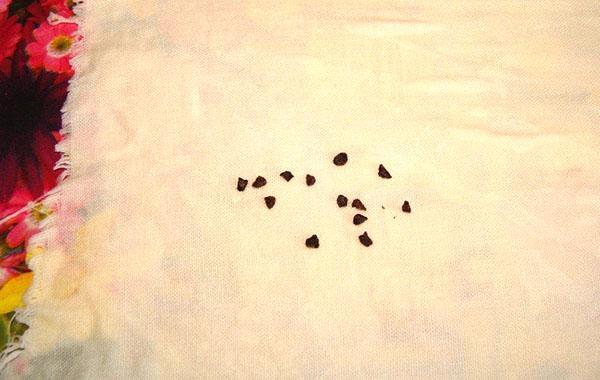 Now you can put the earth in containers and start planting the delphinium with seeds.
Now you can put the earth in containers and start planting the delphinium with seeds.
In order for the flowers to sprout successfully, it is advisable to put the planting material in a gauze bag. Prepare a solution of potassium permanganate, and then lower the seeds there. Soak for 20 minutes, rinse under running water and refill for a day with a special epin liquid, which is sold in flower shops. Dry the seeds before planting.
Planting material is carefully laid out on the soil surface. If different varieties are used, paper labels with the name and date of disembarkation are attached. 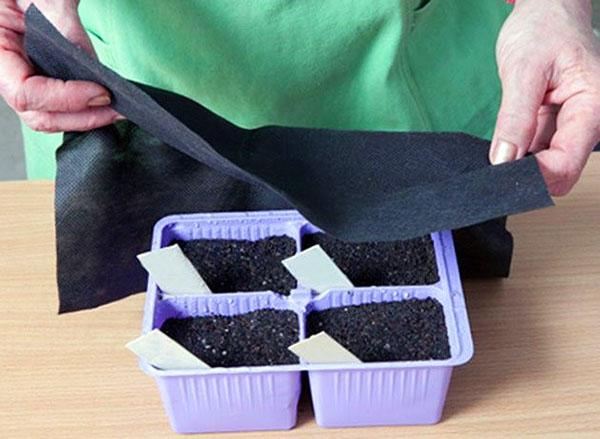 From above, the seeds are covered with a layer of soil of approximately 4 mm. Slightly tamp so that the grains do not float when watering with warm water.
From above, the seeds are covered with a layer of soil of approximately 4 mm. Slightly tamp so that the grains do not float when watering with warm water.
The basic principles of how to grow a delphinium from seeds involve careful maintenance of the crops. To do this, the containers are covered first with transparent film, and then with black, to speed up the growth process. The container is installed near the window, preferably right next to the glass.
The optimal temperature regime should not exceed +16 degrees, not lower than 11 degrees.
Depending on when to plant the delphinium outdoors, the seed growing process can be accelerated. For this, containers with planting material are placed in a refrigerator, on a veranda or loggia. It's not scary if the thermometer drops below 6 degrees below zero. After 14 days, the containers are again placed on the windowsill next to the glass. Thanks to such procedures, the first shoots appear after 7 or 14 days.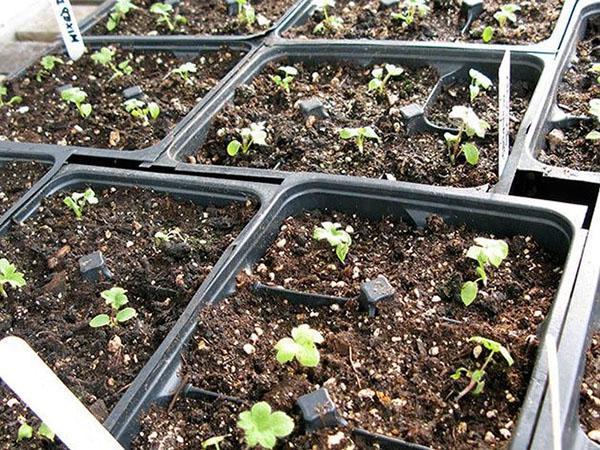
As soon as greens appear in the containers, the transparent and black film must be removed.
Since the seeds of this stately flower are very capricious, they need to be seriously prepared for sowing. Delphinium stratification at home is done with a small roll of fabric. The material is cut into strips, moistened with water and the planting material is laid out in paths. After that, the edges of the strips are folded from the inside closer to the center. Then the fabric structure is rolled up and fixed with soft wire.
A little liquid is poured into a small container to maintain optimal humidity. Rolls are lowered into it, without touching the surface of the water, and kept for several days. At the same time, they try not to block the constant air supply. As a result of this procedure, the similarity of the delphinium increases.
Secrets of breeding a garden handsome
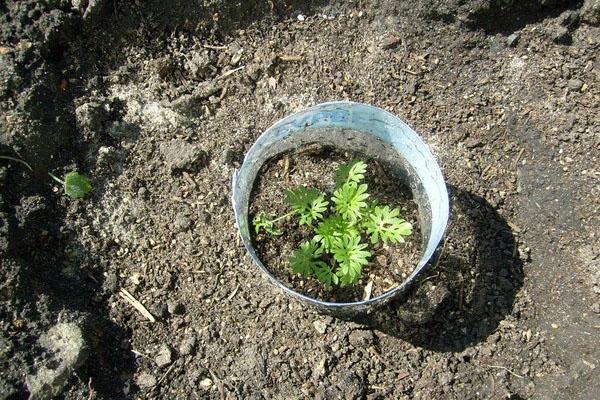 Many flora lovers prefer to decorate their site with large flowers. Someone plants peonies, someone likes roses. An unsurpassed ornamental plant with bright buds on erect shoots has won the hearts of true gardeners. They come with or without the original fringe. The diameter of an individual flower can reach 10 cm. In the lower part, the shoots are covered with wide green leaves.
Many flora lovers prefer to decorate their site with large flowers. Someone plants peonies, someone likes roses. An unsurpassed ornamental plant with bright buds on erect shoots has won the hearts of true gardeners. They come with or without the original fringe. The diameter of an individual flower can reach 10 cm. In the lower part, the shoots are covered with wide green leaves.
Cultivation of a unique flower called "Delphinium New Zealand Giant" from seeds requires the following operations:
- Planting material is laid out on a damp cotton cloth.
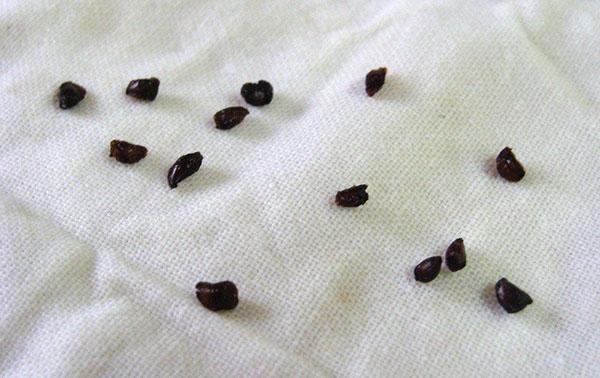
- Distributing it evenly over the area, carefully twist the fabric into a roll.

- To prevent the fabric from drying out, it is placed in a plastic bag.
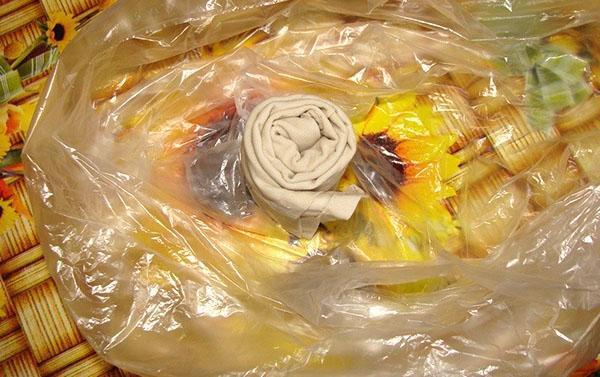
- Send the seeds to the refrigerator.
The bag must be aired daily to maintain maximum seed germination. Some gardeners use special sphagnum moss instead of bags, where the material swells well.
When the seeds are ready, you can use them to sow delphinium seedlings in special containers. Plant grains are placed in holes 3 mm deep and covered with a small layer of earth. 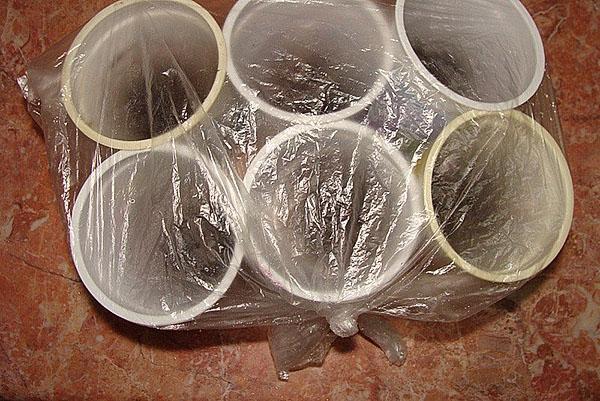 Can be tamped slightly. Then the container is covered with a film or plastic bags are put on it. In this form, they are placed in a warm place. If the house is warm, you can put it on the windowsill. After 3-4 days, containers are sent to the refrigerator overnight. After two weeks, the first shoots appear. As soon as this happens, the film is immediately removed.
Can be tamped slightly. Then the container is covered with a film or plastic bags are put on it. In this form, they are placed in a warm place. If the house is warm, you can put it on the windowsill. After 3-4 days, containers are sent to the refrigerator overnight. After two weeks, the first shoots appear. As soon as this happens, the film is immediately removed.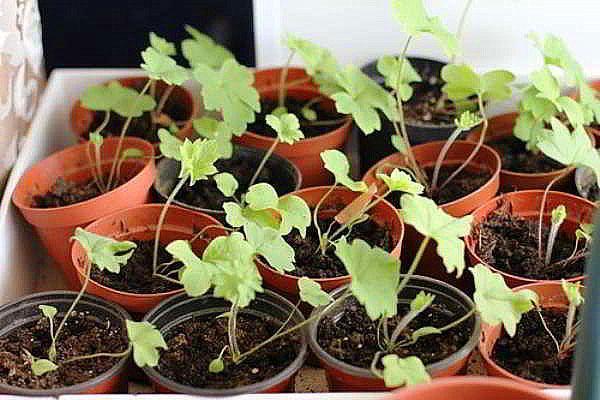
Sometimes flora lovers have a question: when to sow delphiniums for seedlings in order to successfully plant flowers. Experienced gardeners are advised to do this in the late March or early April. It will not be too late to grow seedlings even in May.
Saplings, which have grown three full-fledged leaves, dive. But you should prepare for the procedure in advance. Loose soil is collected in disposable cups and heated to room temperature. Then, one seedling is placed in each container so that it can root well.
To prepare the plant for growing outdoors, it must be hardened. For this, containers are periodically taken out into fresh air. Immediately before planting, the sprouts are fertilized with top dressing.
There is an opinion that the annual delphinium is less capricious when grown from seeds indoors. Perhaps this is so. After all, the plant differs from perennials in that it blooms much earlier. It has small buds and grows only up to a meter in height, while perennials are found in gigantic sizes.
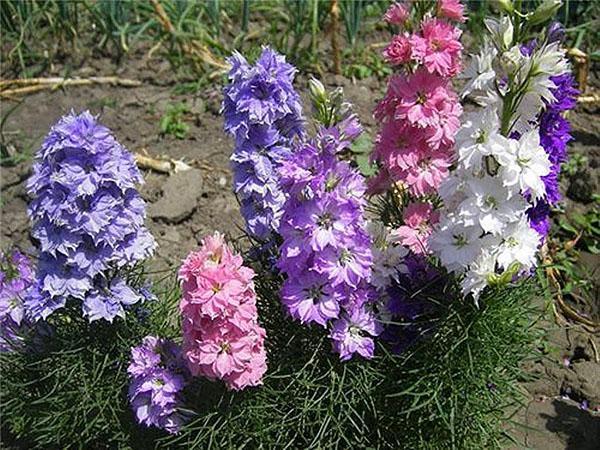 The seeds must be either fresh or stored in the refrigerator. Since the seedling of the flower develops rather slowly, the delphinium is sown at the end of winter. Most often in February. For this, the planting material is carefully prepared by performing the necessary procedures.
The seeds must be either fresh or stored in the refrigerator. Since the seedling of the flower develops rather slowly, the delphinium is sown at the end of winter. Most often in February. For this, the planting material is carefully prepared by performing the necessary procedures.
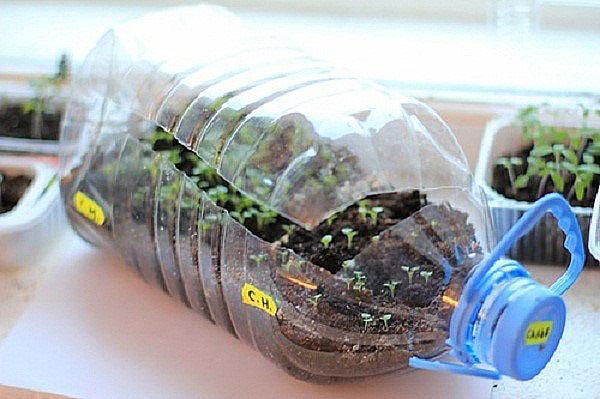 Seeds are sown evenly in small containers filled with soil. To make them clearly visible, the surface of the earth is sprinkled with sand. Practice shows that the sowing density has not the last effect on the development of young seedlings. The best option that gardeners recommend is to spread no more than 2 seeds per 1 cm². While this may seem like a lot, don't worry. For the king, flower beds are the norm.
Seeds are sown evenly in small containers filled with soil. To make them clearly visible, the surface of the earth is sprinkled with sand. Practice shows that the sowing density has not the last effect on the development of young seedlings. The best option that gardeners recommend is to spread no more than 2 seeds per 1 cm². While this may seem like a lot, don't worry. For the king, flower beds are the norm.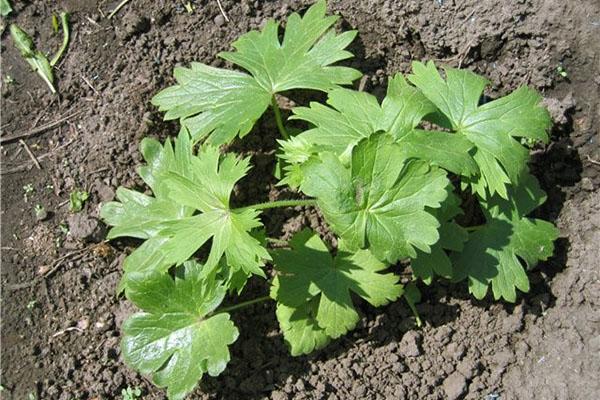
The video provided shows the correct planting of a delphinium with seeds. Having viewed it, it will not be difficult to grow such a magnificent flower in your area. Often, it is the delphinium that becomes the pride of the country flower bed. After all, it fits well into any suburban landscape. The fun process of growing a flower brings true satisfaction to loyal green space enthusiasts.